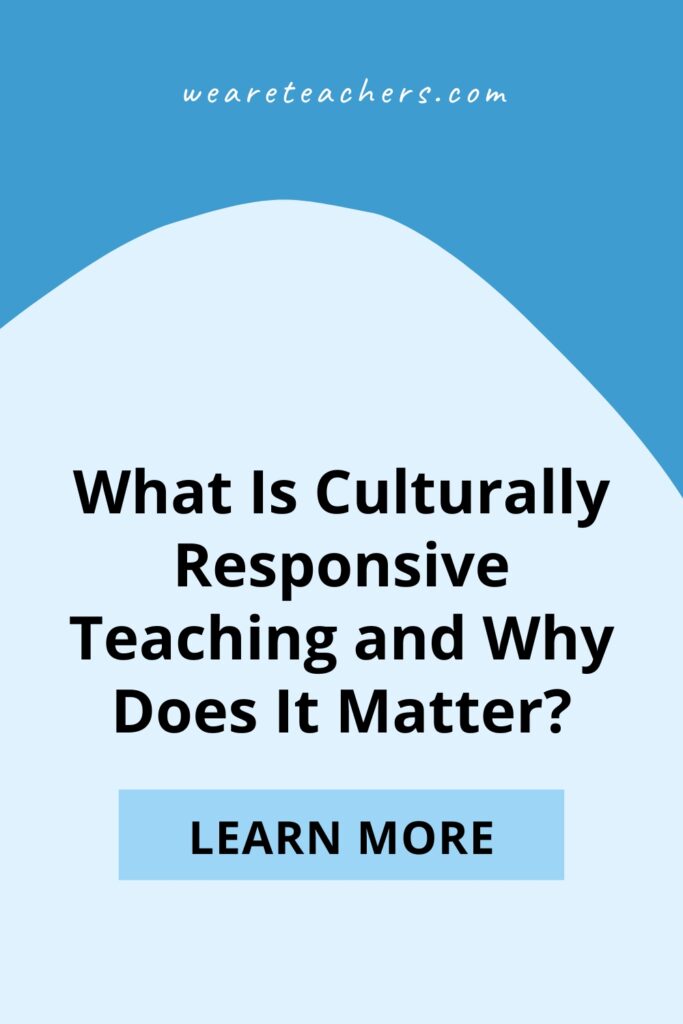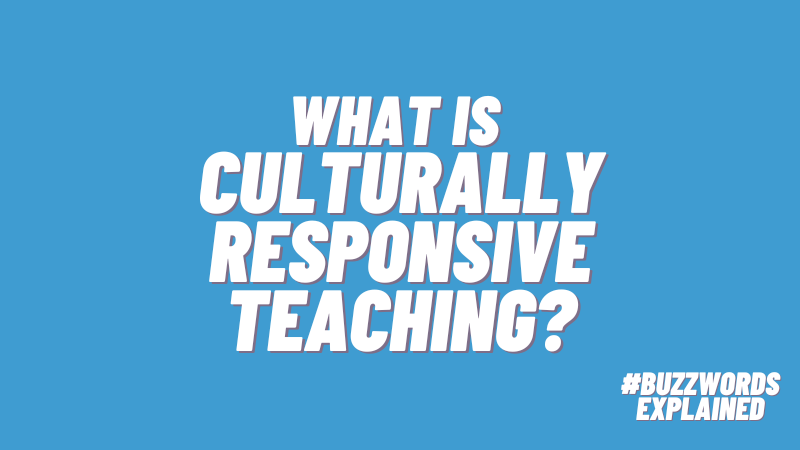Culturally responsive teaching is a hot topic these days, and one that’s full of complexities and nuance. Start your journey with this overview of the basics, then use our list of recommended resources to deepen your understanding and start using culturally responsive teaching strategies in your own classroom.
What is culture?
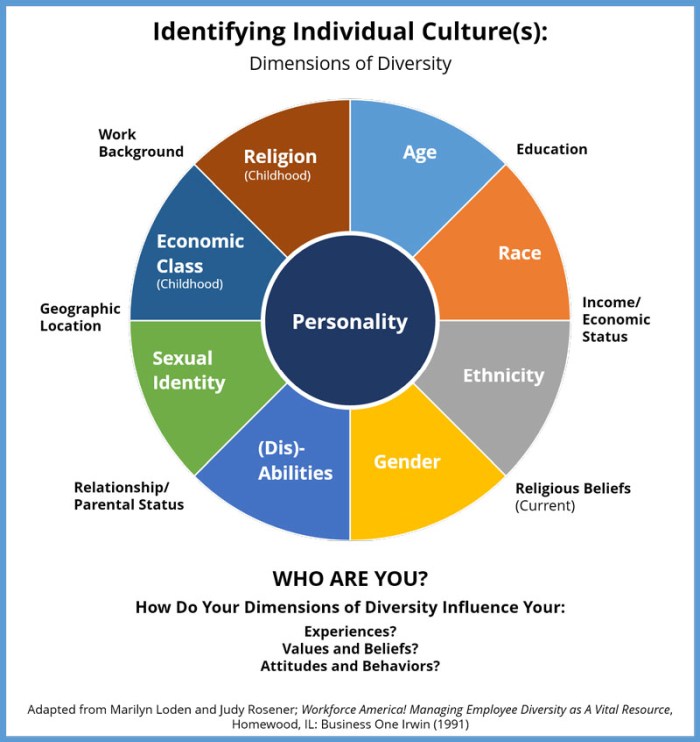
Source: Intercultural Solutions
First, take a step back and consider what “culture” means. When you think of culture, you probably picture the way a group of people who share a common background dress, talk, cook, dance, make art and music, practice religion and ritual, and so on.
Beyond those aspects, culture is the deeply embedded shared connections and beliefs of a group of people. Bear in mind that culture is not necessarily based on race, ethnicity, or nationality. For instance, two people who speak Spanish as their native language can have very different cultures, depending on where they come from and how they were raised. Most people have have multicultural backgrounds. Culture is about what’s passed down from one generation to the next, creating a unique identity for a group of people.
Cultural beliefs and practices are something many of us don’t even think much about, until we come into contact with those whose culture is different from our own. Stepping outside our own culture can feel uncomfortable, especially if we feel that other cultures view our own as somehow “less.” While it’s good to learn about different cultures, it’s important that we feel our own is respected.
What is culturally responsive teaching?
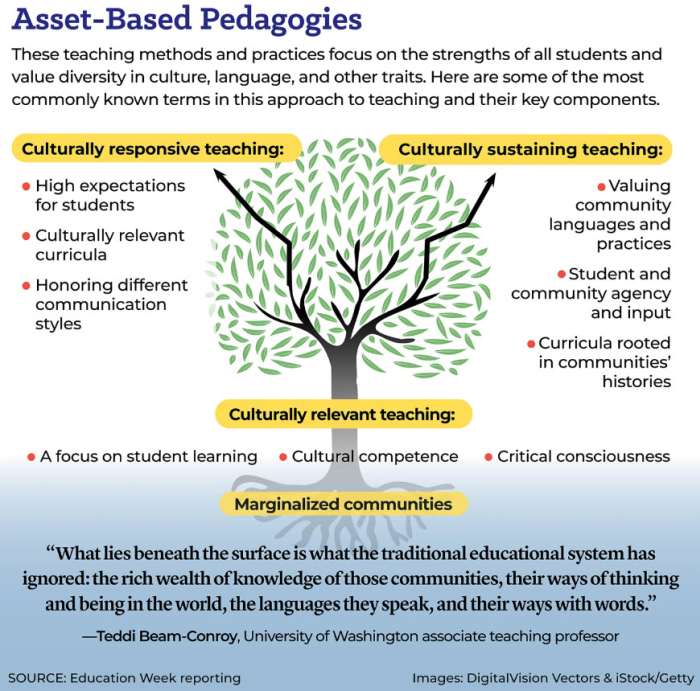
Source: Education Week
Culturally responsive teaching is based on the understanding that we learn best when we can connect with the material. For culturally responsive teachers, that means weaving their students’ various experiences, customs, communication styles, and perspectives throughout the learning process.
Geneva Gay first used the term in 2000 in her book, Culturally Responsive Teaching: Theory, Research, & Practice. She found that students from historically marginalized cultures performed better academically when teachers made an effort to frame instruction “within the lived experiences and frames of reference for students.”
In other words, Gay encourages teachers to consider whether their learning materials, instructional strategies, and classroom environment truly represent the various cultures in their classroom. Are your classroom books written by people from those cultures? Are different communication styles respected? Do you relate your learning objectives to real-world experiences of all cultures? Do you hold all students to high standards, regardless of their background?
By asking these questions, Gay sparked the culturally responsive teaching movement. It’s part of a broader category known as “asset-based pedagogy,” and it has wide-ranging applications and implications. Other related terms include “culturally relative teaching” and “culturally sustaining teaching.”
Does culturally responsive teaching really make a difference?
In short, yes. Many teachers can share anecdotal evidence of how culturally responsive teaching makes a big difference for their diverse students. But if you’re looking for hard facts, consider this study done in 2016. It examined hundreds of students across different cultures and found that “Teaching methods that connect with students’ real lives and interests and promote understanding of other cultures are associated with better academic outcomes.” Other studies concur.
Culturally responsive teaching can help at-risk populations stay in school, see the relevance in learning, and believe they can learn. Culturally responsive teachers feel more connected to their students, especially when they learn to see cultural behavioral differences as an asset rather than a problem. Putting learning into relevant context, using differences to your advantage, and acknowledging inequality and inequity when it exists are concepts every teacher should add to their tool box.
What does culturally responsive teaching look like in the classroom?
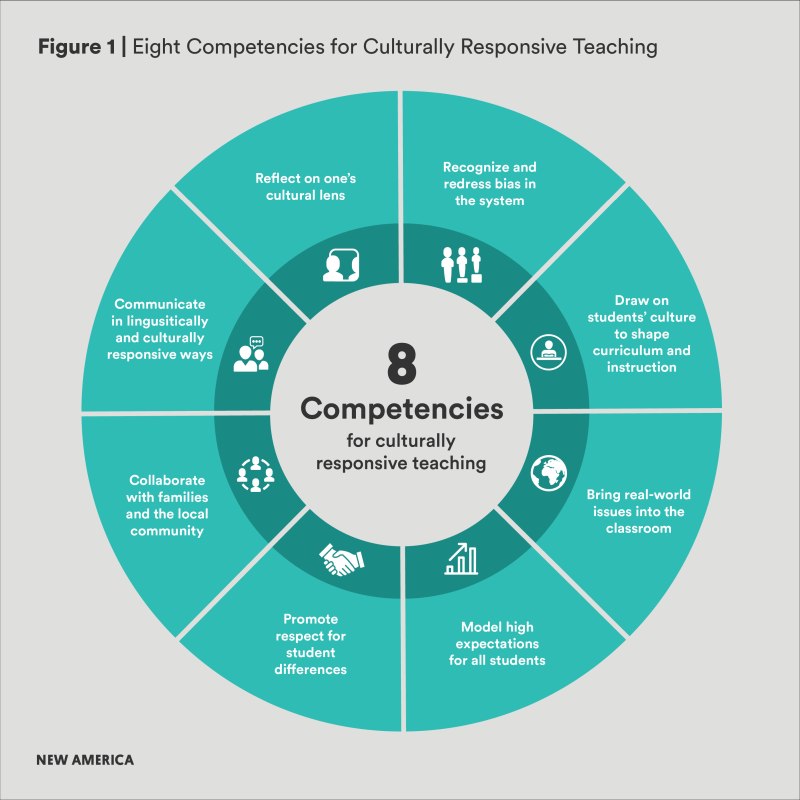
Source: New America
While putting this into practice is a little different in every situation, there are some consistent strategies culturally responsive teachers use. Here are some examples:
Embrace background knowledge
Consider this story problem: “Chaoxiang’s family is gathering for this year’s Qingming Festival, and he wants to bring enough qingtuan for every one to have two. If there will be 14 people there, how many dumplings should he bring?”
If you’re not familiar with Chinese culture, you probably see words you not only don’t know, but aren’t even sure how to pronounce. In fact, if you don’t realize that qingtuan is a form of dumpling, you might not know how to find the answer to the problem.
Students from different backgrounds in American schools can face similar situations, making learning unfamiliar and uncomfortable. Think about what your students already know from their daily lives, and use it as you create lessons and materials. Look for the stories, idioms, and beliefs they learn at home, and find ways to incorporate them. Look into the concept of Funds of Knowledge for more ways to bring background knowledge to the forefront.
Bring multiple cultures into your examples and lessons
As the saying goes, “If you can see it, you can be it.” Make sure your students see themselves represented in what they’re learning. Want to explore symbolism? Ditch the same three poems by English poets that you’ve been teaching for years. Instead, find examples of works by writers from your students’ own backgrounds. Better yet, ask them to bring in their own examples.
Select materials that represent your students
Look around your classroom. Does your library contain books by diverse authors, on topics that appeal to the cultures represented by your students? What about your classroom decorations—do they show faces and cultural elements similar to those of your own students’? Kids should see that their teacher knows not everyone has the same experiences and values, and that’s OK.
Bring learning into context
No matter what their culture, all kids eventually ask the same question: “Why does learning this even matter? What does it have to do with my life?”
So, take some time to address that. Perhaps you’re learning about ancient Greek civilization. Talk about how life then was similar or different to today’s. Consider the social divides, the political events, and family structure. Discuss how your students today can learn from the mistakes made then, or what elements of their society they think we could benefit from today.
Accommodate different communication styles
“Don’t interrupt.” “Wait to be acknowledged before you speak.” “Look directly at someone when you talk to them.” These are all pretty standard classroom guidelines, yet they’re specific to only a few cultures. In some cultures, interrupting isn’t rude, it shows interest. Making eye contact can be hard for some, even culturally discouraged.
Explore how different cultures communicate, and learn to accommodate them in your classroom. That doesn’t mean no rules it all. It means understanding that there could be cultural reasons for why it’s harder for some kids to wait their turn to talk, while others are reluctant to speak up. Don’t get angry—understand, learn, and adapt.
Set high standards for all students
Studies into implicit bias reveal that some teachers expect less from students who are from non-white communities. They assume they haven’t had the same advantages as their white peers and therefore won’t be able to achieve as much.
But research tells us that’s exactly the wrong way to think. Teachers need to overcome their implicit bias, and set equitable expectations for all students. You’ll always need to take individual situations into account, of course. But don’t make assumptions based on culture. Hold every student to high standards, and take each case as it comes.
Acknowledge inequity, bias, and injustice
This is getting harder to do in some places, as states ban teaching about things like critical race theory. But inequity, bias, and racial injustice exist, and ignoring them won’t make them go away. What’s more, allowing students from different cultures to hash these things out in the classroom lets them feel seen. And this opens them up to more learning.
There’s no easy answer for navigating these topics in more restrictive states. Teachers can only do their best in the classroom, and continue to fight for the ability to teach vital topics in meaningful ways.
How can I become a more culturally responsive teacher?
As we said earlier, culturally responsive teaching is a complicated topic. You can’t learn everything you need to know from one article or even one book. Learn more about your students’ rich cultures, and find out what interests them. Open yourself up to new ideas, do more research, and start trying out the principles in your classroom. Here are some resources to help you:
- 9 Areas of Your Teaching to Evaluate for Diversity & Inclusion
- Prioritizing Culturally Responsive Teaching in the Classroom
- 10 Anti-Racism Professional Development Books for Teachers
- What Are Mirrors, Windows, and Sliding Glass Doors?
- Education Week: What Is Culturally Responsive Teaching?
- Understood: How To Use Culturally Responsive Teaching in the Classroom
- Center for Culturally Responsive Teaching and Learning
Culturally responsive teaching is a complex topic, so come talk it over and ask for advice in the WeAreTeachers HELPLINE group on Facebook.
Plus, What Culture Day Gets Wrong and What To Try Instead.
